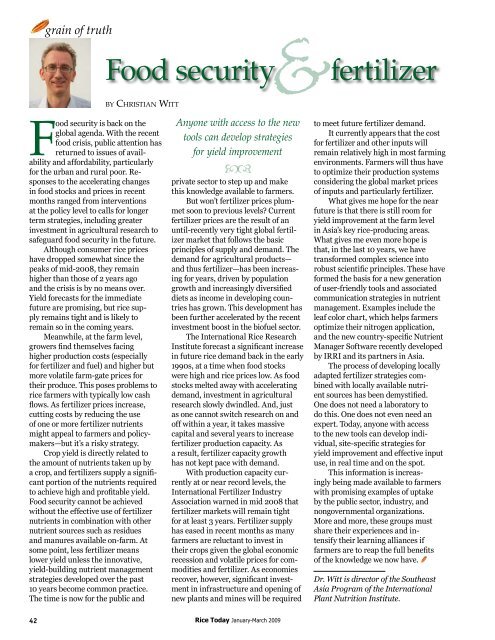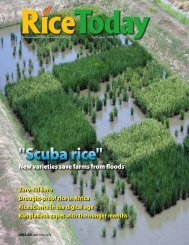How much water does rice need? - adron.sr
How much water does rice need? - adron.sr
How much water does rice need? - adron.sr
You also want an ePaper? Increase the reach of your titles
YUMPU automatically turns print PDFs into web optimized ePapers that Google loves.
grain of truthFood securityby Christian Witt&fertilizerFood security is back on theglobal agenda. With the recentfood crisis, public attention ha<strong>sr</strong>eturned to issues of availabilityand affordability, particularlyfor the urban and rural poor. Responsesto the accelerating changesin food stocks and p<strong>rice</strong>s in recentmonths ranged from interventionsat the policy level to calls for longerterm strategies, including greaterinvestment in agricultural research tosafeguard food security in the future.Although consumer <strong>rice</strong> p<strong>rice</strong>shave dropped somewhat since thepeaks of mid-2008, they remainhigher than those of 2 years agoand the crisis is by no means over.Yield forecasts for the immediatefuture are promising, but <strong>rice</strong> supplyremains tight and is likely toremain so in the coming years.Meanwhile, at the farm level,growers find themselves facinghigher production costs (especiallyfor fertilizer and fuel) and higher butmore volatile farm-gate p<strong>rice</strong>s fortheir produce. This poses problems to<strong>rice</strong> farmers with typically low cashflows. As fertilizer p<strong>rice</strong>s increase,cutting costs by reducing the useof one or more fertilizer nutrientsmight appeal to farmers and policymakers—butit’s a risky strategy.Crop yield is directly related tothe amount of nutrients taken up bya crop, and fertilizers supply a significantportion of the nutrients requiredto achieve high and profitable yield.Food security cannot be achievedwithout the effective use of fertilizernutrients in combination with othernutrient sources such as residuesand manures available on-farm. Atsome point, less fertilizer meanslower yield unless the innovative,yield-building nutrient managementstrategies developed over the past10 years become common practice.The time is now for the public andAnyone with access to the newtools can develop strategiesfor yield improvementprivate sector to step up and makethis knowledge available to farmers.But won’t fertilizer p<strong>rice</strong>s plummetsoon to previous levels? Currentfertilizer p<strong>rice</strong>s are the result of anuntil-recently very tight global fertilizermarket that follows the basicprinciples of supply and demand. Thedemand for agricultural products—and thus fertilizer—has been increasingfor years, driven by populationgrowth and increasingly diversifieddiets as income in developing countrieshas grown. This development hasbeen further accelerated by the recentinvestment boost in the biofuel sector.The International Rice ResearchInstitute forecast a significant increasein future <strong>rice</strong> demand back in the early1990s, at a time when food stockswere high and <strong>rice</strong> p<strong>rice</strong>s low. As foodstocks melted away with acceleratingdemand, investment in agriculturalresearch slowly dwindled. And, justas one cannot switch research on andoff within a year, it takes massivecapital and several years to increasefertilizer production capacity. Asa result, fertilizer capacity growthhas not kept pace with demand.With production capacity currentlyat or near record levels, theInternational Fertilizer IndustryAssociation warned in mid 2008 thatfertilizer markets will remain tightfor at least 3 years. Fertilizer supplyhas eased in recent months as manyfarmers are reluctant to invest intheir crops given the global economicrecession and volatile p<strong>rice</strong>s for commoditiesand fertilizer. As economie<strong>sr</strong>ecover, however, significant investmentin infrastructure and opening ofnew plants and mines will be requiredto meet future fertilizer demand.It currently appears that the costfor fertilizer and other inputs willremain relatively high in most farmingenvironments. Farmers will thus haveto optimize their production systemsconsidering the global market p<strong>rice</strong>sof inputs and particularly fertilizer.What gives me hope for the nearfuture is that there is still room foryield improvement at the farm levelin Asia’s key <strong>rice</strong>-producing areas.What gives me even more hope isthat, in the last 10 years, we havetransformed complex science intorobust scientific principles. These haveformed the basis for a new generationof user-friendly tools and associatedcommunication strategies in nutrientmanagement. Examples include theleaf color chart, which helps farmersoptimize their nitrogen application,and the new country-specific NutrientManager Software recently developedby IRRI and its partners in Asia.The process of developing locallyadapted fertilizer strategies combinedwith locally available nutrientsources has been demystified.One <strong>does</strong> not <strong>need</strong> a laboratory todo this. One <strong>does</strong> not even <strong>need</strong> anexpert. Today, anyone with accessto the new tools can develop individual,site-specific strategies foryield improvement and effective inputuse, in real time and on the spot.This information is increasinglybeing made available to farmerswith promising examples of uptakeby the public sector, industry, andnongovernmental organizations.More and more, these groups mustshare their experiences and intensifytheir learning alliances iffarmers are to reap the full benefitsof the knowledge we now have.Dr. Witt is director of the SoutheastAsia Program of the InternationalPlant Nutrition Institute.42 Rice Today January-March 2009

















